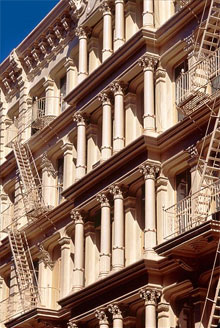 |
 |
The Artists of SoHo Creating a Legendary Art Community While Protecting Architectural Treasures 
Photo credit Andrew Prokos In the late 1960s and early 1970s, New York City's artists forged a new downtown community known as SoHo, the neighborhood "South of Houston Street" and North of Canal Street, located on the west side of Manhattan. They enthusiastically embraced the notion of combining residential and commercial real estate (living in their workspaces) and became pioneers who created an eclectic, avant-garde community in an area considered by many in the City's government to be urban blight. In the 1600s, SoHo was a wilderness area of grassy hills, streams, meadows, forests, and marshes. Trails through the wilderness led to Indian settlements; present-day Broadway, for example, was known as the Weckquaesgeck Trail. Dutchman Augustus Herman bought several tracts of land during this period, many of which were within what is now SoHo. The 1700s saw the development of large farms, which were later in the century divided into smaller parcels. The early 1800s was an elegant period in SoHo's history. Mostly residential, the neighborhood was inhabited by the wealthy, and soon after, the middle class. In time, there was rapid development of the area, as stately mansions and numerous business enterprises - hotels, restaurants, retail stores, theaters, gambling casinos, minstrel halls - sprang up along Broadway, the Fifth Avenue of its day. Horse drawn carriages made their way down cobblestone streets lined with gaslight lamps. As activity increased, smaller adjacent streets began to develop. Bordellos were common, and the city's first red-light district was soon established. After the Civil War, by the 1880s, million-dollar textile industries had settled in the area. The population centers shifted uptown, and industry and commerce took over, with their manufacturing buildings and warehouses dotting the landscape. There were import/export houses, trucking companies, and wholesale textile establishments. The "rag trade" took center stage in SoHo, as inexpensive clothing outlets moved to the area, many of which remain to this day. It was not until the 1950s that a new breed of settlers filtered into the area - creative, artistic individuals with imagination, a zest for living, and an economic need for low rents. At that time, SoHo's lofts, which were especially desired by artists because of their vast spaces, expansive windows, and natural lighting, were not zoned for residential living; New York City and the New York State Assembly, however, accommodated by creating special exceptions to the zoning laws. It was now possible for "starving artists" to live in their workspaces relatively inexpensively. SoHo boasts the greatest collection of cast-iron structures in the world, which adds considerably to the aesthetic of the neighborhood. Approximately 250 cast-iron buildings exist in New York City, the majority of which are in SoHo. Cast-iron, an American architectural innovation, was initially used as a decorative front placed over pre-existing nineteenth century buildings. These embellishments (less expensive than brick and stone) were much needed improvements, as new commercial clients were looking to establish their businesses in the area. SoHo is an outstanding example of inner city regeneration and gentrification, encompassing socio-economic, cultural, political, and architectural development. The SoHo loft is a concept now widely used by developers everywhere to describe this unique style of living space. Modern loft developers have expanded the idea by using fashionable materials such as hardwood floors, installing custom-designed kitchens and bathrooms, and adding fitness centers, landscaped terraces, and barbecue areas. No longer are lofts just for artists; all types of people call Manhattan lofts home. It was artists who brought the "SoHo mystique" and concept of loft-living to the fore. One such artist was Bevy Seger, a Midwesterner who, in middle-age, when artists were flocking to SoHo, decided to leave her home and head for New York City to pursue her dreams. She drove to New York with all her worldly possessions in her car and little cash. "Everyone said I couldn’t move to New York City at my age with no money," recalls Bevy. Not heeding that advice, she rented an industrial loft in SoHo and immediately got busy designing unique handbags and accessories, at times using scraps from local clothing manufacturers left in boxes by street curbs to be hauled away by refuse companies. Her resourcefulness paid off, as her creations were soon featured in Women's Wear Daily and Harper's Bazaar. With an entrepreneurial spirit, she then decided to transform some unused space in her loft into a bed & breakfast inn. In no time, Bevy's Bed & Breakfast had landed a spot in the publication New York's 50 Best Wonderful Little Hotels. Her guests have been diverse - from film producers and actors, to tourists, students, psychics, and Tai Chi masters. Bevy also created a line of postcards featuring her pen and ink drawings of the people and architecture of SoHo, accompanied by written historic documentation relating to the artwork. She wanted to share not only SoHo's history through her card line, but also the vision of SoHo that she and so many others had turned into a reality. Bevy, like many other SoHo artists, was saddened when SoHo had eventually become an enclave for the wealthy, with "some lofts renting for over $20,000 a month and selling for over a million dollars." She noted that many of the original artists who turned SoHo into such a unique community could no longer afford to live there and were forced to move to other parts of the City. © Copyright 2009 Preserve America |